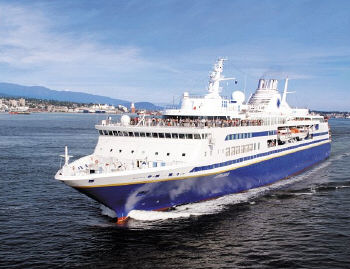Guide to Semester at Sea Pt 1: Applying and Preparing
by Tom Muller
 The allure of international travel grabbed my attention instantaneously. Hearing stories from friends and acquaintances that had participated in past Semester at Sea voyages fueled my desire to apply to the program that included stops in various countries around the world. Exotic images of remote locations are difficult to suppress when an itinerary includes places like Brazil, India, and Myanmar. Countries that many people only hear about in passing suddenly become accessible and part of your immediate future. Browsing the fall 2005 semester’s itinerary only served to stir my excitement and raise my anticipation level.
The allure of international travel grabbed my attention instantaneously. Hearing stories from friends and acquaintances that had participated in past Semester at Sea voyages fueled my desire to apply to the program that included stops in various countries around the world. Exotic images of remote locations are difficult to suppress when an itinerary includes places like Brazil, India, and Myanmar. Countries that many people only hear about in passing suddenly become accessible and part of your immediate future. Browsing the fall 2005 semester’s itinerary only served to stir my excitement and raise my anticipation level.
The Semester at Sea program sails three semesters throughout the year including the fall, spring, and an abbreviated 65-day summer trip. Each 100 day voyage around the world offers approximately 750 college students the chance to earn a semester worth of college credit while porting in ten distinct countries. Not only do participants spend time in each country, but they are afforded the chance to live with students from about 650 prospective colleges. This abroad program offers students the chance to change views, shape life experiences, open the imagination, and possibly learn more in one semester than in any previous year of college.
Sounds amazing, so how hard is it to actually apply? In all truth it is a rather simple process. But, before actually applying it is important to take into consideration the experience that Semester at Sea provides. It will be unlike any normal college semester a student could experience, even when compared to other, more traditional, study abroad programs. Take into serious account that after the semester is over, there could be a shift in global views and a realization that world is different than previously pictured. Some may not feel comfortable with such an endeavor, but by all means apply if you have the slightest desire to have the most rewarding semester of your entire college experience.
Applying for a Semester at Sea Program
 In order to be considered for Semester at Sea, the applicant must be enrolled at an accredited college/university, not limited to institutions within the United States. The Institute for Shipboard Education states that a 2.75 minimum G.P.A. is expected and that the candidate must have already completed a full semester before they will be considered for a voyage. The majority of students on the ship seemed to be either of junior or senior standing at a four year institution, with some students falling outside the norm. The admission process runs on a rolling basis, and requires an application fee of $50. Meeting the general list of criteria set forth was a basic accomplishment as is the rest of the process. By visiting the SAS website, semesteratsea.org, the online application is readily accessible. The application is a straightforward set of questions; it will most likely take up a transient and painless half an hour of your time. In addition to the application, students are merely required to submit an official transcript from their school, a discipline clearance form, and a brief 300-500-word essay dealing with current world issues. Simple and worth every minute of the time spent on it.
In order to be considered for Semester at Sea, the applicant must be enrolled at an accredited college/university, not limited to institutions within the United States. The Institute for Shipboard Education states that a 2.75 minimum G.P.A. is expected and that the candidate must have already completed a full semester before they will be considered for a voyage. The majority of students on the ship seemed to be either of junior or senior standing at a four year institution, with some students falling outside the norm. The admission process runs on a rolling basis, and requires an application fee of $50. Meeting the general list of criteria set forth was a basic accomplishment as is the rest of the process. By visiting the SAS website, semesteratsea.org, the online application is readily accessible. The application is a straightforward set of questions; it will most likely take up a transient and painless half an hour of your time. In addition to the application, students are merely required to submit an official transcript from their school, a discipline clearance form, and a brief 300-500-word essay dealing with current world issues. Simple and worth every minute of the time spent on it.
Completing all of the necessary documents is the most time consuming part of the entire process. After submitting the application and documents it becomes apparent that waiting for the acceptance letter is far more stressful than it ever was completing the application. Time gradually passes, allowing the admissions process to occur and your acceptance letter arrives welcoming you to your selected voyage. Be aware that financial matters are probably the most important part of the application process. Clear all financial aid packages, payments, and scholarships with your home institution. Many students faced several meetings with the bursar over missed payments or complications in aid from their institution. Your final dealings with the Institute for Shipboard Education concerning the application will be a brief set of questions dealing with roommate requests and/or compatibility, the participant’s medical history, and emergency contact forms. Upon submission of all the documents the application process has been completed.
Preparing for Your Semester at Sea
 Visas, visas, visas. That is the crucial word for your pre-departure checklist. When the final weeks of August roll around and the embassies in India and China are just receiving your passport, the anxiety level quickly rises. A word of advice, do not wait to fill out the appropriate paperwork for your visas that are required prior to departure. There were several students on my particular voyage that were forced to leave for the first port of call without their passport, only hoping to receive it before they boarded the ship. My passport, filled with recently completed visas, arrived at my home only four days before I departed for the Bahamas. Since the itinerary varies from semester to semester, it is difficult to name the countries that will require a visa, but the program makes it their goal to disperse clear and up-to-date information. Semester at Sea employs the help of a travel document company, which eliminates a lot of the worry that students would have to face alone. Pinnacle Travel Document Systems (TDS) was responsible for contacting the appropriate embassies and consulates in order to secure all of the students the documentation needed. Simply submit the visa applications, the fees required, and your passport to them and the process will be taken care of by the company.
Visas, visas, visas. That is the crucial word for your pre-departure checklist. When the final weeks of August roll around and the embassies in India and China are just receiving your passport, the anxiety level quickly rises. A word of advice, do not wait to fill out the appropriate paperwork for your visas that are required prior to departure. There were several students on my particular voyage that were forced to leave for the first port of call without their passport, only hoping to receive it before they boarded the ship. My passport, filled with recently completed visas, arrived at my home only four days before I departed for the Bahamas. Since the itinerary varies from semester to semester, it is difficult to name the countries that will require a visa, but the program makes it their goal to disperse clear and up-to-date information. Semester at Sea employs the help of a travel document company, which eliminates a lot of the worry that students would have to face alone. Pinnacle Travel Document Systems (TDS) was responsible for contacting the appropriate embassies and consulates in order to secure all of the students the documentation needed. Simply submit the visa applications, the fees required, and your passport to them and the process will be taken care of by the company.
While the visas are being processed, it is time to start thinking about travel to the ship. Each semester a discount travel agent, such as BCD Travel or World Travel BTI, is commissioned to provide the Semester at Sea participants with less expensive airfare and hotel rooms in both the port of departure and arrival. It is a good idea to call the travel agent and at least request a quote of prices they are offering. I would also suggest scouting additional sites for information like cheaptickets.com, STA Travel, etc. World Travel was able to provide a better rate at the Atlantis Resort than any other source I checked, but their airfare was more expensive than cheaptickets.com. Most students conveniently congregate at a few key hotels in the departure and arrival city. Take into consideration spending a few days in the departure city; it makes for a splendid way to start out the semester. It also provides the opportunity to meet fellow participants before departing for the next few months. Parents and friends are sometimes brought along in order to have someone there for send off; I personally left my parents at the airport in New York.
Communication from the Ship
 Speaking of parents, communicating with people at home while you are traveling the world is an issue that will arise when planning the semester. Global phones are offered through Semester at Sea with a price tag that has a tendency to grow quickly. Calling home on the satellite phone can become an expensive endeavor, but while on the sea your only other option is a twenty dollar calling card provided by Semester at Sea. If you do not feel the need to make contact by phone from the ship, then all of the ports offer much more reasonable calling card prices. Thankfully, the internet is also available. Choosing to forgo the satellite phone will not be the end of the world, but it might let you save money that could be put to experiencing a little more of the world.
Speaking of parents, communicating with people at home while you are traveling the world is an issue that will arise when planning the semester. Global phones are offered through Semester at Sea with a price tag that has a tendency to grow quickly. Calling home on the satellite phone can become an expensive endeavor, but while on the sea your only other option is a twenty dollar calling card provided by Semester at Sea. If you do not feel the need to make contact by phone from the ship, then all of the ports offer much more reasonable calling card prices. Thankfully, the internet is also available. Choosing to forgo the satellite phone will not be the end of the world, but it might let you save money that could be put to experiencing a little more of the world.
Money Matters
Semester at Sea also provides the service of having foreign currency sent to you before departure. Skipping the money service may in fact be a wise choice. ATM machines and currency exchanges are readily available in every port of call and will offer a better rate than the pre-order service. Travelers Cheques are useful, but I personally did not bring any and was able manage perfectly fine. Cashing the travelers cheques can become a hassle since the ship limits the dollar amount that can be cashed on a daily basis. If you need the money for an upcoming port, cashing the cheques should begin to occur a few days before arrival. Save up your one dollar bills they will be extremely useful in markets, particularly in Asian countries. Notifying your personal bank of the countries you will be visiting is wise. You will avoid extemporaneous problems if your bank is aware that credit and debit cards are going to be utilized in several foreign countries.
Packing for Semester at Sea
 It would be superb if there was a mini-guide to packing for Semester at Sea, and so here is mine. No matter whom you speak with the opinion will vary but having a checklist will be beneficial. First and foremost, all environmental conditions should be taken into consideration before packing occurs for your voyage. Make note of the itinerary’s ports and at what time of the year the ship will arrive. Extreme cold is usually avoided, but with some of the excursions students may experience a wide array of temperatures. Layering is the key to cold weather survival on Semester at Sea. With a weight limit on luggage for air travel no one wants to stuff a bulky winter jacket in their bag, so the way to avoid that predicament is to pack a few long sleeve shirts. Button downs, long sleeve tees, and light sweaters are all suitable articles of clothing to pack. Now think southern India under full sun or the Mekong Delta’s high humidity, lightweight and breathable is key. Cotton tees or logo tees are probably the most widely utilized article of clothing both on the ship and in the countries. Easy to pack, comfortable, and lightweight, they are the ultimate item. Two weeks worth of underwear is sensible since the ship offers laundry services and each cabin has a sink suitable for washing a few articles of clothing. Shorts and skirts are a smart item to pack, but be aware that religious sites in many countries have restrictions upon what articles of clothing are allowed. Three pairs of jeans was the most common number, I did find them to become repetitive, but packing only three saved room for more crucial items.
It would be superb if there was a mini-guide to packing for Semester at Sea, and so here is mine. No matter whom you speak with the opinion will vary but having a checklist will be beneficial. First and foremost, all environmental conditions should be taken into consideration before packing occurs for your voyage. Make note of the itinerary’s ports and at what time of the year the ship will arrive. Extreme cold is usually avoided, but with some of the excursions students may experience a wide array of temperatures. Layering is the key to cold weather survival on Semester at Sea. With a weight limit on luggage for air travel no one wants to stuff a bulky winter jacket in their bag, so the way to avoid that predicament is to pack a few long sleeve shirts. Button downs, long sleeve tees, and light sweaters are all suitable articles of clothing to pack. Now think southern India under full sun or the Mekong Delta’s high humidity, lightweight and breathable is key. Cotton tees or logo tees are probably the most widely utilized article of clothing both on the ship and in the countries. Easy to pack, comfortable, and lightweight, they are the ultimate item. Two weeks worth of underwear is sensible since the ship offers laundry services and each cabin has a sink suitable for washing a few articles of clothing. Shorts and skirts are a smart item to pack, but be aware that religious sites in many countries have restrictions upon what articles of clothing are allowed. Three pairs of jeans was the most common number, I did find them to become repetitive, but packing only three saved room for more crucial items.
Aside from trekking outdoors, several of the cities that will be visited are home to thriving nightlife. It is a nice idea to pack a few articles of clothing appropriate for bars or nightclubs. You really do not need 20 different shirts suitable for a trendy bar, but four or five offers the option in case those situations do arise. In terms of formal or dressy casual wear, one pair of pants and a tie will suffice for males, and a sole dress for the females. Unless you plan on wearing them out, the Ambassador’s Ball is truly the only time they will be worn. If you feel like saving the space in your luggage while packing, there are opportunities to purchase very nice or even custom made pieces in port. Spending a majority of the semester in equatorial regions of the world provides for excellent sun bathing, and given that the ship has a pool equipped with lounge chairs a bathing suit is crucial. Flip flops are a shipboard necessity. A day on the ship will not go by without you seeing at least half of the ship meandering about in a pair of flip flops or sandals. Think about bringing a pair of sneakers that can be worn comfortably with copious amounts of walking or hiking. Plus add a few pairs of sneakers or shoes that are suitable for city walking or going out at night.
 Pack up your favorite DVDs, pleasure reading material, and iPod or mp3 player. They all come in handy during downtime on the ship. You can avoid bringing any travel books with you since the onboard library has copies of Lonely Planet available. Essentially, the camera and memory stick are the most important electronic devices to bring. Some other items to throw into your bag should include bug spray with DEET, suntan lotion, laundry detergent, and your personal preference of toiletries.
Pack up your favorite DVDs, pleasure reading material, and iPod or mp3 player. They all come in handy during downtime on the ship. You can avoid bringing any travel books with you since the onboard library has copies of Lonely Planet available. Essentially, the camera and memory stick are the most important electronic devices to bring. Some other items to throw into your bag should include bug spray with DEET, suntan lotion, laundry detergent, and your personal preference of toiletries.
You’re Ready to Go!
Preparations are nearly completed as your final few days home fade away. It is important to come to terms with the person you see yourself as prior to Semester at Sea. Sit down alone and think about what you want to get out of your rapidly approaching time abroad. It can easily become a semester that is comparable to an extended spring break. Allowing that to happen would not only be disheartening, but would also mean you neglected to take full advantage of all Semester at Sea has to offer. Saying good-bye is the final step in welcoming the semester. Tears may be shed, kisses given, and a final embrace shared but take heart that everyone leaving is experiencing the same emotion – feelings of excitement, trepidation, anticipation and most of all the indistinguishable yearning to adventure around the world.
>> Continue reading Guide to Semester at Sea Pt 2: The Experience of a Lifetime